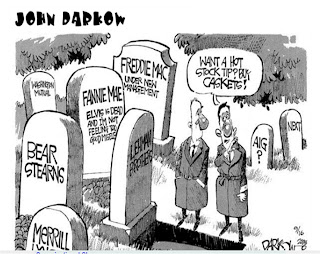This write-up only touches the main historical events which lead to the 2008 Economic crisis. More elaborate discussions on the Crisis and bubble will follow this post.
When did the crisis started?
- 2007?
- 2001?
- 1999?
- 1981?
- 1973?
- 1971?
- 1944?
- 1936?
1936 – Keynesian Theory
- The year Keynesian Theory was published.
- Keynes in a letter to G B Shaw boasted “economics would never be same again” and he was damn right as It was not.
- Keynes taught spending as salvation, government as savior, deficit finance as the weapon.
- He asserted ‘ unemployment and inflation are mutually exclusive
- In decades thereafter, the western world took Keynesian advice right and very wrong.
1944 – Bretton Woods
- IMF was established
- Dollar was accorded the status of the King of Currencies. It was made currency of reserve.
- Fixed exchange rates establish with currency tied to dollar and dollar to gold.
- Undervalued currencies distorted trade.
- US acquired enviable capacity to write ‘cheque on it self’.
- And US used the prerogative abundantly
- And irresponsibly with excesses in spending and debt.
- US deficits in budget, in trade, US expanding money supply and US debt wrote the script of crisis.
1971 – Nixon
- Nixon closed the gold window ending twenty five years of fixed prices giving way to more excesses and loss of faith in dollar.
- Smithsonian realignment of currency was short lived.
1973 – Oil Shock
- OPEC oil shock changed the macroeconomic of world
- Oil producing countries acquired upper hand and license to amass wealth
- US developed vested interest in high oil prices – as producer and as beneficiary and keeper of oil wealth.
- Keynes’ exclusivity of unemployment and inflation went for a toss creating dilemma and inefficacy of monetary and fiscal policy which aggravates crisis.
- G7 decided to maintain value of Dollar by intervention.
1981 – Regan and Deng Xiaoping
- Backlash of capitalism and free market – not only in the west but in Communist China
- Deregulation and encouragement to amass wealth
- 401 (k) and other measures to create equity culture
- Plaza meeting of G8 in 1987 and triggering depreciation of dollar – wealth acquired by countries could and did lose its value.
1999 - IT bubble, Y2K and Repeal of Glass Steagall Act
- IT bubble is born and grows
- Y2K facilitates ‘outsourcing’
- Power shift
- Rise of China as World’s factory and of India as its back office.
- Accelerates globalization enabled by IT
- Glass Steagall repealed wiping out demarcating line between commercial banks and investment banks. Invitation to take more risk. This was the costliest mistake by the US senate and was done to facilitate the merger of Citigroup with Travelers. It proved to be the last nail in the coffin and the crisis became apparent in 2007-08.
2001- Bush, IT bubble burst and WTC
- Bush paints a rosy picture of making America an Ownership Society
- Refunds $ 168 to no avail
- Reduces taxes. Rich get $ 450 bn + benefit out of total $ 650 bn cut
- Capital gains tax rate (15 %) at half the income tax rate (30 %).
- IT bubble bursts creating ‘mini crisis of confidence’
- Further setback with 9/11 and WTC collapse
- Initiates Greenspan Put and Housing Bubble.
Housing Bubble -2004-07
- Surge in housing with cheap money, easy mortgage availability and belief that house prices would always rise
- Sub-prime and NINJA loans
- ARM and zero and negative equity loans
- HELCO and Refi loans making existing houses ATM
- Alt-A loans – minimum or no documentation
- Securitization and the finance bubble
- 2007 Crisis Begins with Bursting of Housing Bubble Followed by Finance Sector Crisis on the Wall Street.
Growth of Economy due to the Bubble Growth
- Housing triggers economic growth
- With cheap money, failure rates fall; falling failure rates trigger more irresponsible lending
- “We have no way to know a bubble till it bursts” – Alan Greenspan
- “While the music plays, you have to dance” Charles Price, CEO Citi Group
- 65 % home ownership in 2001, 69% in 2006
- Sub-prime $ 145 billion in 2001 $ 625 billion in 2005
- In 1998 Real Estate Agents 718,000; in 2006 1.37 million
- In 2000 mortgage brokers 240,000; in 2006 418,700
- By 2005, 40 % home purchases for investment or second homes
- HELOC (Refi) increased from $ 59.1 Billion in 4th qtr 2001 to $ 206.7 billion in 3rd qtr 2004
- In fall 2005, Mark Zilbert Miami Realtor launched www.condoflip.com with motto “bubbles are for washtubs”.
- Mortgages $ 304 billion in 2001, $ 985 billion in 2004, $ 2.9 trillion in 2005.
- ARM share 12 % of mortgage in 2001 to 19 % in 2004 to 31% in 2005
- Foreclosure fell from 1.49 % in third quarter 2002 to less than 1 % in second quarter of 2005
- 952 days without a bank failure since June 2004
September 2008 - Humpty Dumpty had a Great Fall
- Bear Stearns folds up in March with high exposure to sub-prime losses
- Dollar collapses in July 2008. Euro=$ 1.59
- Oil at $ 147 a barrel
- Nero fiddles “I am an optimist” – Bush in July 2008
- Avalanche moves. In September, Fannie Mae and Freddie Mac are effectively taken over
- Money market dries. Difference in LIBOR and US 90 days TBs rises to 345 basis points
- Crisis of confidence in markets. Dow slides
- Lehman in trouble. Paulson decides to let it fall. On 15th September, Lehman files for Bankruptcy
- Panic ensues
- AIG is effectively nationalized with Govt. pumping $ 85 bn in bail out against 80% stock of AIG. Total AIG funding $ 210 bn and counting
- House passes TARP on second attempt Bailout Package of $ 700 billion
- Meltdown is global – Systemic risk implodes
- Dow at less than 6,500
- On October 13th, government recapitalizes banks – total support over time $ 350 billion
- In November Obama wins Presidency.
Let’s look at the factors which propelled the Bubble(s)
- Capitalist Expansion and Ownership Society
- Cultural and Political Changes Favoring Business Success
- New Information Technology
- Supportive Monetary Policy and Greenspan Put. Cheap money.
- An Expansion in Media Reporting of Business News
- Analysts’ Optimistic Forecast. Role of rating agencies.
- The Expansion of Defined Contribution Pension Plans (401 (k))
- The Growth of Mutual Funds
- Expansion of the Volume of Trade: Discount Brokers, Day Traders and Twenty-Four-Hour Trading
- The Rise of Gambling Opportunity. Refinancing and flipping
- Financial innovation. Securitization, packing, repacking, slicing, debt. Alphabet soup of ARM, MBS, ABS, CLO, CDO, CDO squared, cubed, Synthetic CDO, CDS, Alt-A, SIVs, conduits.
- Global liquidity and global market for debt paper.
- Enhanced risk taking due to low failure rate. Sub-prime lending
- Baseless optimism on continued rise in prices
- Moral Hazard
- Global savings glut (Chinese fund American Excesses)
- Iraq and Afghanistan Wars (Chinese pay for it)
- Absence of regulation
- Domino effect
- Rising Inequality of Income – Middle Class Squeeze. Let them eat credit.
- Increasing gap between rising productivity and constant remuneration.
Further readings







